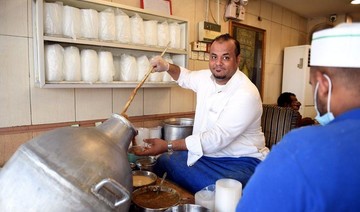JEDDAH: Around the world, Ramadan is a special time for Muslims to get together with family and loved ones and share meals that take on added significance during the holy month. The culture in Saudi Arabia is diverse, and the people are keen on preserving and upholding the traditions. The older generation often reminisces about the good old days, when things were simpler — including the food.
Um-Khalid, who is 77 years old, and Abu-Khalid, 80, from Hail, have been married for more than 55 years. They recalled simpler times gone by, when the region’s harsh conditions meant that people opted for simple but hearty Ramadan dishes.
“Iftar during Ramadan was usually simple,” said Um-Khalid. “We’d break our fast over Arabic coffee and dates that we would buy in Buraidah, which is known for the best types to this day. We would then either eat a good, hefty meal after Taraweeh prayers or before, depending on my husband’s liking.”
“I always had a sweet tooth,” said Abu-Khalid. “I like having hanini, which is a mix of dates, wheat flour, ghee and sugar. Sugar was a commodity in those days and we rarely had any but Um-Khalid would use it specially for me during Ramadan.”
“He still loves hanini to this day,” adds Um-Khalid. “For large gatherings, thareed was the dish that you’d always find on our table. We made thareed when had a good collection of vegetables, and it’s based on small pieces of lamb cooked with zucchini, carrot and potatoes, placed on thin bread.”
Um-Majid comes from the lush, green, mountainous region of Rijal Almaa in the southern province of Asir region.
“We grew up tending to our sheep and crops from an early age, so it was more tiring during the days of Ramadan,” she said.
“My mother would wake up early in the morning to tend to our iftar meal. Khubz, which is your typical bread made with wheat flour, was made fresh everyday alongside our aseeda. It was a two-person task, where my mother cooked pitted dates in a deep pan filled with water and mixed in with wheat flour on a low heat for at least at hour. The mix thickens and when it resembled a gooey dough, it would be served with ghee and sometimes honey. It was a hearty meal, which she said would keep our bones strong and healthy for our daily tasks.
“Our Arabic coffee was slightly different from other regions. It’s slightly bitter because we infuse it with crushed cloves for a stronger flavor.”
Makkah and Madinah are historically significant cities in Islam. Um-Ghassan remembers traveling between them, as her father was a merchant.
“The house was always busy,” she said. “Growing up in a family of nine children, the boys would tend to my father’s store while we girls stayed with our mother.
“The majlis was always in tip-top shape — or ‘metabtab’ as my mother would say. Zamzam water in a clay jug was always infused with incense from Mastik gum, with silver tu-tu cups too.
“My sisters and I helped my mother prepare our favorite Ramadan dishes, always after Dhuhr prayers. We made buff samboosa (samosa), foul (made fava beans) and grain soup, and there was always subya juice, which my father made himself,” she added.
“Subya was made by immersing in water cut, dry loaves of wheat bread, sugar, cardamom, cinnamon and yeast and letting it sit overnight. Since we didn’t have a modern fridge, it was made daily. My mother said it replenished our bodies so we wouldn’t be thirsty the next day.
“The table was always ready when the men came back from breaking their fast in the Holy Mosque. There’s not much difference on today’s table — except for maybe chicken nuggets, of course.”
Um-Lama recalled her grandmother’s tales about Ramadan, when their tribal caravan traveled around Al-Ahsa region in the east, long before King Abdul Aziz reunified the land.
“I learned the best desert dish from my grandmother,” she said. “She remembered Ramadan as a young child to be in the cold winter months and they’d always have a sweet dish called al-safseef ready. It contained a lot of small razeez dates from local farms, with date syrup or honey, a bit of ginger powder, and sweet cumin brought in from abroad. Nowadays, we add almonds for decoration.”













